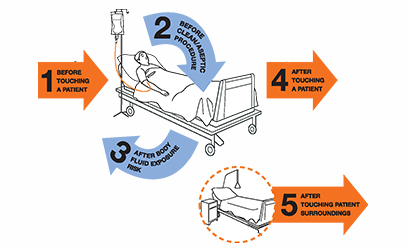
The use of central and peripheral venous catheters are commonly used in health care delivery worldwide. When these devices are used, there remains risks posed to patients for the development of bloodstream infections (BSI). In this course, you will learn more about these specific types of infections, recommended best practices for insertion, maintenance, and removal and ways to achieve effective implementation for prevention.
Please note: These materials were launched on 05/12/2022.
Language: English
Health topic
Course information
Peripheral and central venous catheters are commonly used in health care delivery worldwide, with up to 70% of all inpatients requiring a peripheral intravenous catheter (PIVC) at some time during their in-hospital stay. These devices increase a patient’s risk for developing bloodstream infections (BSIs) and other local infections in and around the insertion site. In this section, you will learn about case definitions of BSIs due to catheter use, its epidemiology and the risk factors for acquiring BSIs.
Learning objectives:
By the end of this course you will:
- define key terms and case definitions;
- describe the epidemiology and risks for infections associated with the use of peripheral and central venous catheters;
- describe best practice for catheter insertion;
- describe best practice for catheter care and removal;
- describe approaches for conducting BSI surveillance;
- list prevention practices that help reduce BSI; and
- explain how multimodal strategies can effectively prevent infections associated with the use of peripheral and central venous catheters.
Course duration: Approximately 2 hours.
Certificates: A Record of Achievement will be issued to participants who receive at least 70% on the post-test. You have an unlimited number of attempts to meet the threshold. Participants who receive a Record of Achievement can also download an Open Badge for this course. Click here to learn how.
Course contents
Epidemiology & Risk Factors:
Peripheral and central venous catheters are commonly used in health care delivery worldwide. These devices increase a patient’s risk for developing bloodstream infections (BSIs) and other local infections in and around the insertion site. In this section, you will learn about case definitions of BSIs due to catheter use, its epidemiology and the risk factors for acquiring BSIs.Prevention of vascular-catheter-associated BSI: Best Practices:
In this section, you will learn about recommended best practices for insertion, maintenance, and removal of PIVC, PICC and CVC). The section will also cover strategies to achieve effective implementation for prevention of BSI). Regarding PIVCs and PICCs, these are mostly based on Part 1 of WHO Guidelines for the prevention of bloodstream infections and other infections associated with the use of intravascular catheters. The full link to the guidelines can be found here: https://www.who.int/publications/i/item/9789240093829
Enroll me for this course
Certificate Requirements
- Gain a Record of Achievement by earning at least 70% of the maximum number of points from all graded assignments.
- Gain an Open Badge by completing the course.